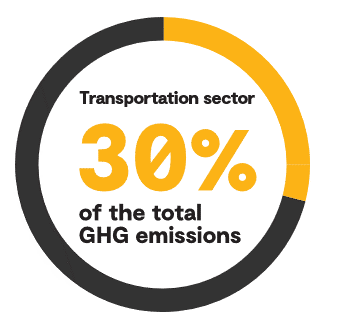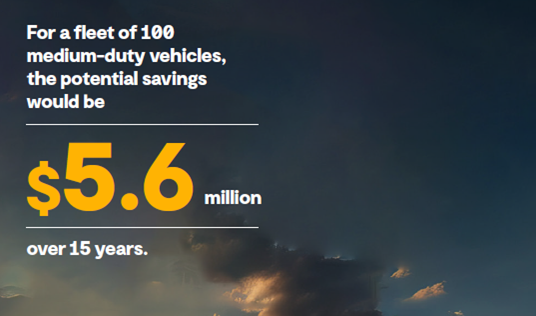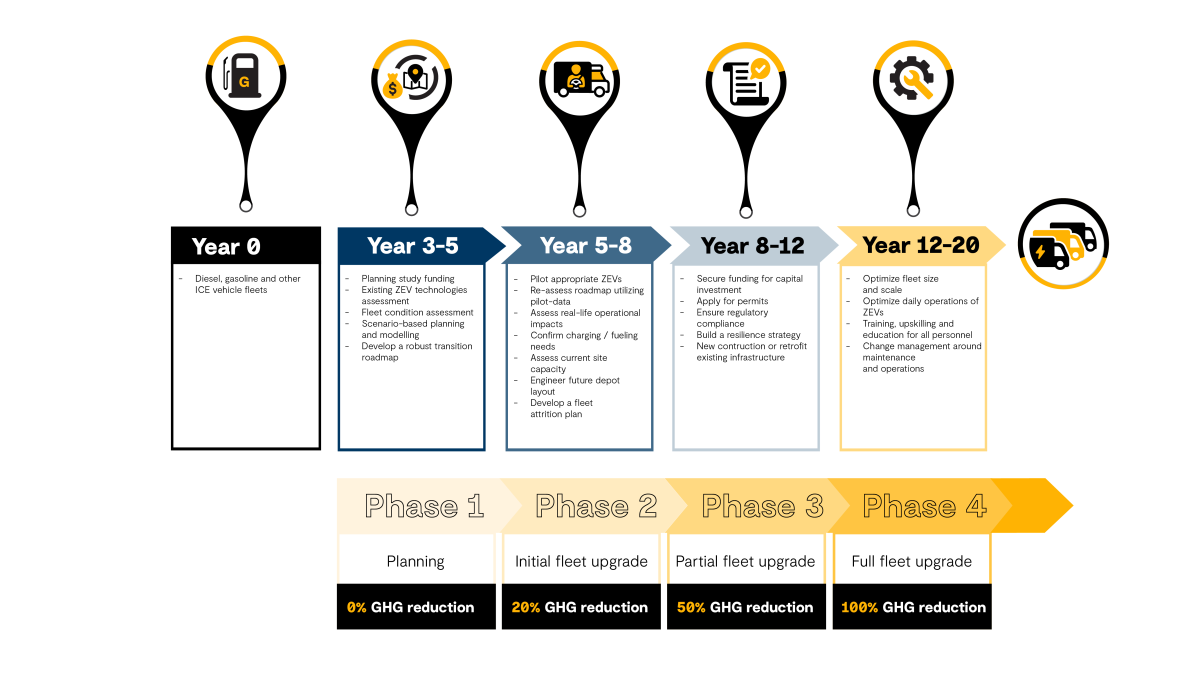By Rippan Bhattacharjee
Recently, I had the pleasure of publishing an amazing roadmap to fleet decarbonization, a practical, actionable guide to start on your organization's way to a greener, decarbonized future. The paper titled “The Shift: Accelerating your fleet decarbonization journey” takes you through everything from why sustainable transportation is no longer negotiable but an imperative, the health benefits, how profitability meets sustainability and all in all, answering the question, “Is it worth it?”.
In our spotlight article today, I would like to focus more on the big question on everyone’s mind – “Is it really worth it?”. I will explain how traditional to decarbonized fleets reveal a harmonious link between sustainability and financial gains.
 How it started
How it started
A large portion of the transportation sector is made up of fleet vehicles, which contribute as much as 30 percent of all greenhouse gases in Canada and the United States. As a result, fleet decarbonization, through various alternative fuel solutions, can provide an economically and logistically feasible pathway to improve the environment and combat climate change as Canada and the USA progress towards aggressive 2050 net-zero goals.
Is it worth it?
One might question whether the benefits of fleet decarbonization outweigh the associated costs. The answer becomes clear when we examine the financial advantages of embracing sustainable transportation solutions. A company with 100 heavy-duty vehicles could save an estimated $15.1 million over 15 years by converting from conventional fuel vehicles to clean vehicle alternatives based on total cost of ownership differences. Savings stem mainly from the cost disparity between fossil fuels and clean fuels/electricity. Renewable energy sources like wind, hydro, and solar produce electricity at significantly lower costs per kWhr compared to fossil fuels. Additionally, ZEVs do not require oil changes and exhibit simpler powertrains, resulting in reduced maintenance costs compared to traditional vehicles. In addition to these clear advantages, there are various strategies to maximize the financial benefits of zero-emission vehicles (ZEVs).

Charging Strategy
Electricity tariffs in Canada vary by province, but most utility companies adopt a straightforward approach: they charge a premium during peak demand hours and offer discounts during off-peak periods. Fleet operators can capitalize on this by using power sparingly during peak times and ensuring their entire fleet charges overnight or during off-peak hours. This can be achieved through manual intervention by depot personnel or by deploying a smart system like an Electrical Vehicle Energy Management System (EVEMS), which optimally schedules charging based on real-time tariff rates and distributes the available power accordingly among all connected vehicles. The main challenge is ensuring that all vehicles have sufficient charge for their daily operations the next day. To address this, fleets can create a comprehensive 'Charging Strategy' tailored to their specific needs, covering various operational scenarios, and serving as a guide for depot personnel in managing parking, maintenance, and availability to ensure uninterrupted operations.
Vehicle to Grid
Electric companies impose premium charges during 'peak hours' due to the high demand that strains the grid. In extreme cases, they may purchase power from third parties to meet this demand. For major fleet operators with a fleet of battery-electric vehicles, these vehicles collectively form a mini-grid of interconnected batteries. This presents an opportunity for operators to contribute to their local grid and generate revenue by supplying power when needed. This technology is known as V2G or Vehicle to Grid, where the EVEMS system leverages available and inactive zero-emission vehicles to draw power and feed it back into the grid during peak-demand periods. To pursue this opportunity, fleet operators should establish agreements with utility companies, and their 'Charging Strategy' should reflect this partnership. A robust V2G solution can result in substantial cost savings on the energy front.
Operational Efficiency
This monumental shift in fuel usage necessitates fleet operators to extend their focus beyond emissions and cost savings. A fleet of zero-emission vehicles presents opportunities for optimizing operational efficiency, directly impacting the bottom line. ZEVs and their charging infrastructure act as data generators, and data itself holds intrinsic value. Real-time vehicle telematics enables monitoring vehicle health and driving behaviour, facilitating driver training and operational decisions. Regenerative braking enhances energy efficiency through intelligent driving practices. Data-driven route optimization uncovers and addresses inefficiencies, reducing distance, idling, and traffic congestion.
Charging as a Service
Given the substantial investment required to design and construct a depot charging system, exploring strategies for monetizing this infrastructure beyond the primary fleet charging is essential. The increased electrical capacity within the depot can be effectively utilized to establish charging stations for public parking, either managed by the fleet owner or outsourced to a third-party 'Charging-as-a-Service' (CaaS) provider. The CaaS model allows maintenance, operation, and profit generation from the charging station, with the site owner receiving rent or other fees. CaaS can yield substantial revenue streams, helping recover the initial fleet transition investment and creating a dependable source of income for future enhancements or acquisitions.
Data as a Commodity
The rich data from ZEVs can serve various third-party interests, offering an ecosystem of win-win situations for fleet operators and third-party stakeholders.
What can GHD do to realize the ROI
Our experience and expertise can lead businesses and municipalities through a successful decarbonization journey that minimizes the risk of the transition while maximizing its benefits. A key component of any fleet decarbonization project is to analyze data that maximizes operational efficiency. GHD’s ZEVO does just that. ZEVO is a proprietary platform developed for fleet operators to seamlessly analyze and understand the complexities of a vehicle fleet transition to zero emissions. The basic principle of ZEVO is to transform fleet and operational data into various decarbonization timeline scenarios, allowing the fleet owner to implement its decarbonization strategy.
While ZEVO enables the upfront feasibility assessment for any fleet transition, lengthy and complex processes present challenges to a successful transition. To address those challenges, a comprehensive four-phased approach draws on ZEVO’s analytical toolset to optimize any fleet transition project, regardless of fleet type, fuel type or industry and includes everything from mining to agricultural vehicles to last-mile delivery vans. These phases are Planning, Real-World Testing, Implementation Planning, and Optimization and Sustainment.
Planning involves a careful and thoughtful planning phase to ensure a solid foundation for a successful fleet transition. This phase involves defining goals and ambitions, conducting robust feasibility studies, and accurate life-cycle assessments of the new fleet.
Real-World Testing with a few pilot vehicles will provide valuable insights and validate the feasibility studies and life-cycle analysis to ensure the chosen vehicle is suited to the unique operating environments where the fleet will operate.
Implementation Planning is the detailed design, engineering, and planning phase, which includes applying for government funds, exploring public and private sources of capital, securing permits to construct new depots, along with fueling and charging infrastructure.
Optimization and Sustainment is the final phase in the fleet transition. This phase involves optimizing operational strategies for the new fleet to take advantage of the unique strengths the new fleet has and to minimize any weaknesses. Managing changes in operations and maintenance and designing new standard operating procedures and schedules for the fleet will be critical in this phase.

In closing
Transitioning to a decarbonized fleet is a multifaceted journey with many essential pitstops. Having a comprehensive roadmap can help to ensure that the pivot is successful. Using GHD ZEVO ensures that an organization’s decarbonization goals can be prompt and cost-effective. A detailed and comprehensive transition strategy can be developed faster by removing the guesswork. This new innovative tool can achieve a brighter and more environmentally responsible future.
Stakeholders looking for effective ways to prioritize zero emission goals and support the global energy transition have viable solutions at the ready. Collaborating and embracing technology-driven solutions can accelerate decarbonization, significantly mitigating climate change. Fleet decarbonization is key to achieving environmental sustainability and meeting ambitious climate targets.
I want to encourage companies and municipalities to act quickly to optimize their fleets, monitor usage, and invest in ZEV-friendly infrastructure. We can make history as we navigate towards a zero-emission future by taking the first step and exploring fleet decarbonization with us today.
I invite you to connect with me to explore fleet decarbonization further and discover your fleet-specific requirements while understanding the CO2 reduction potential of transitioning to clean technologies.
About GHD
GHD is a leading professional services company operating in the global markets of water, energy and resources, environment, property and buildings, and transportation. Committed to a vision to make water, energy and communities sustainable for generations to come, GHD delivers advisory, digital, engineering, architecture, environmental and construction solutions to public and private sector clients. Established in 1928 and privately owned by its people, GHD’s network of 11,000+ specialists is connected across more than 160 offices located on five continents.
GHD in the Americas
GHD has long-standing client relationships, and a significant project and economic footprint in the Americas and represents 40 percent of GHD’s global workforce with nearly 4,000 professionals in over 130 offices in the US, Canada, and Chile. In 2023, our Canadian business was named one of Canada’s Top 100 employers. GHD’s US operations were named a 2023 Best Places To Work for disability inclusion by Disability:IN. GHD ranks #9 in international design firms operating in the US and #6 in Canada according to Engineering News-Record’s 2023 annual survey of key market segments. To find a local office, click here.